- Strategy aims to double mineral exports to $2 billion by 2035.
- Plan includes a “critical minerals” list and regional job growth.
- Environmental impacts to be managed to the highest standard.
The New Zealand Government has unveiled a draft strategy to boost the country’s mining sector, potentially doubling its export value to $2 billion by 2035. Resources Minister Shane Jones announced the Draft Minerals Strategy for New Zealand to 2040 at a community meeting in Blackball, highlighting the economic and employment benefits this initiative could bring.
“Today, in the heart of mining country, I am telling Kiwis they are back in business. No longer will these communities with rich histories intertwined with mining be told they cannot utilise the rich mineral endowments contained in their land,” Jones told the meeting.

The strategy, projected to increase employment by over 2,000 jobs, proposes creating a critical minerals list for New Zealand and conducting a comprehensive stocktake of the country’s mineral resources. Jones emphasized that the plan aims to secure and expand the supply and export potential of minerals, enhancing economic benefits and Crown revenue.
It highlighted areas that could be mined:
- Heavy mineral sands in the waters off the Bay of Plenty and West Coast
- Antimony and gold in Reefton
- Rare earths in the waters off the West Coast
- Lithium in Northland and Waikato
- Hydrogen in Waikato, Tasman and Southland
- Vanadium and titanium in the waters off Taranaki
- Potash in Canterbury and Otago
- Rare earth and phosphate mining in the Chatham Islands
“New Zealand has suffered from the lack of a clear long-term strategic direction for the development of its minerals estate,” Jones said. “We are aspirational for the sector, aiming to double mineral exports value to $2b by 2035. With the right direction and settings, mining will continue to boost regional opportunities and jobs, increase our self-sufficiency, and be a critical part of this Government’s export-led focus, especially as we take advantage of the global opportunities for new minerals uses.”
The draft strategy, open for consultation until July 31, stresses the importance of managing environmental impacts to the highest standard. Jones underscored the role of minerals in clean energy technologies, noting the increasing global demand for minerals driven by the production of electric vehicles, batteries, wind turbines, and solar panels.
“We have a choice to make – do we contribute to and benefit from this growing market, or do we become the recipients of other countries’ economic effort and output?” Jones asked.
The strategy also acknowledges the significant interests and rights of iwi and hapū in relation to mineral resource management, advocating for greater participation by these groups.
In a statement from Blackball, ACT’s energy and resources spokesperson Simon Court expressed support for the strategy. “A high-wage economy depends on affordable and reliable energy. In other words, we need to drill, baby, drill,” he said.
Court highlighted the need to balance economic growth with environmental sustainability, advocating for innovative solutions to energy and environmental challenges.
Jones concluded by noting that New Zealand’s mineral reserves remain largely untapped, with significant potential to transform the nation’s economy and enhance regional resilience and prosperity.


